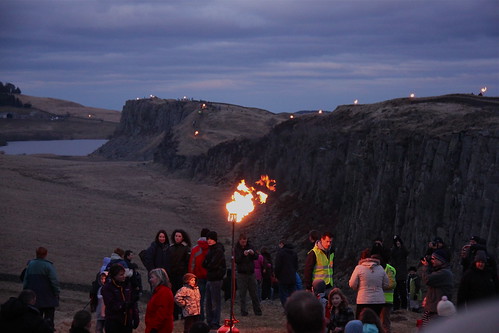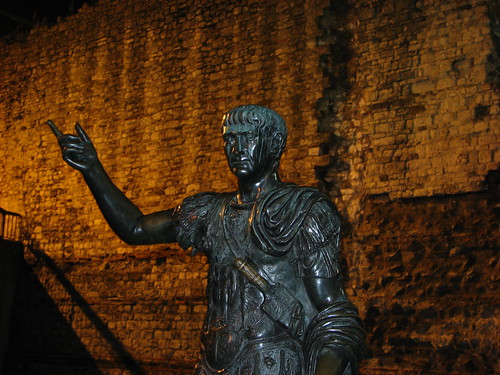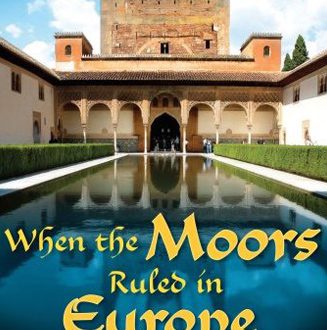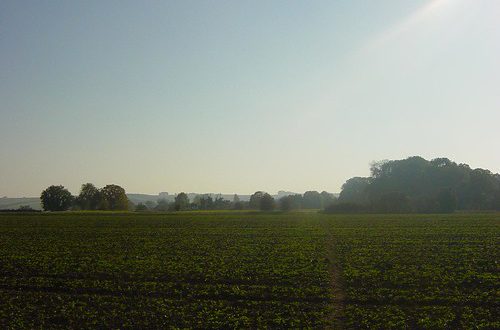 When he arrived in Britain in 122AD, Emperor Hadrian immediately saw a problem. The Roman Empire was already stretched thinner than a Jim Davidson joke, and spreading out into the monstrous back yard of the Picts and Brigantes, two of the island’s fiercest clans, was a hassle he couldn’t afford. So rather than waste energy fighting, Hadrian set about cordoning off Britannia with an 84 mile-long stone wall, manned by thousands of soldiers with its own towns and forts.
When he arrived in Britain in 122AD, Emperor Hadrian immediately saw a problem. The Roman Empire was already stretched thinner than a Jim Davidson joke, and spreading out into the monstrous back yard of the Picts and Brigantes, two of the island’s fiercest clans, was a hassle he couldn’t afford. So rather than waste energy fighting, Hadrian set about cordoning off Britannia with an 84 mile-long stone wall, manned by thousands of soldiers with its own towns and forts.
But while Hadrian’s Wall ligatured Britannia’s frozen north, the southern capital of Londinium was also at risk of attack. And while wooden walls and several forts marked the city limits, it took until 200AD, a full 140 years after Boudicca had torn through the city, for Londinium to get the stone barricade we see today.
Most of London’s Wall has been lost in the 1,800 years since its construction, but fearsome chunks still viewable at Tower Hill, St Alphege Gardens and other places show what an impressive feat of engineering it was. Standing up to 6m (20ft) high, it was an ample deterrent against raging Celts. Constant additions until the 4th century ensured the wall kept Londinium from suffering its Boudiccan fate twice, and it was even used to defend the city from a Saxon raid in 457AD.
Check out our Ancient World in London videos from Hadrian’s Wall and Roman London.
The two scripts are obviously key, but let’s face it, in a head-to-head face-off between the two, which do you think would win? Let’s consider the facts…
Hadrian’s Wall
Hadrian’s Wall was built over a six-year period, between 122 and 128AD. It was commissioned by Emperor Hadrian,one of the Roman Empire’s most successful rulers.
Reasons for the wall’s construction have been debated over the years, but the three most common are that 1) it was meant to keep out the mad Picts and Brigantes, Celtic tribes roaming the area who were decidedly prickly about becoming Roman subjects; 2) it was built to secure valuable mineral and metal deposits in the area; and 3) it allowed the Empire to command in Britannia without spreading themselves too thin – border troubles blighted Hadrian’s rule, from Northumbria to north Africa.
The wall covers a total distance of 84 miles, from Segedunum Fort at Wallsend to the Solway Firth, Cumbria.
Up to 18,000 soldiers built the wall, and around 15 per cent of the entire Roman army was stationed on the wall at some point or other.
The wall’s fortifications are immense for the era: milecastles (tiny outposts) were built roughly every Roman mile (about 0.9 modern miles), and no fewer than 26 forts, such as Vindolanda and Procolita (Carrawburgh) lined the route.
Emperor Antoninus Pius all-but abandoned the wall during the 140s to create his Antonine Wall, some 100 miles further north. But Pius never conquered the region, so when his successor Marcus Aurelius took power in 161, he retreated back to Hadrian’s Wall.
Vindolanda has proved a fascinating insight into the daily lives of Roman soldiers and their families. It is home to the Vindolanda Tablets, a series of ink-written wooden ‘postcards’ from the frontline. These range from requests for more socks and shirts, to the invite to a birthday party.
A local newspaper recently reckoned it would take around 1,500 workers two-and-a-half years, at a cost of 400million ($601million) to make the wall today (it has cost around 990m to build Dubai’s Burj Khalifa, the world’s tallest building).
PLUS POINTS:
- It represents the frostbitten edge of the Roman Empire at its greatest strength.
- Its 84 miles make it a huge defence system by anyone’s standards (except, possibly, the Chinese)
- Vindolanda and its tablets provide a rare insight into the daily lives of Romans.
- The number of people used to build and man the wall are, in Roman terms, staggering.
LET-DOWNS:
- The wall is as narrow as 1.8m in places, rendering it as good as ceremonial compared to the area’s natural defences.
The London Wall
London’s wall was built between 190-220AD. In total the wall stretches almost three miles, from Blackfriars to the Tower of London. The evidence for its dating comes from a forger, whose imitation silver denarii coins, and a real denarius dated 213-17, were found in a tower stairwell at Old Bailey.
The wall was made from ragstone, a grey limestone quarried from the Kentish town of Maidstone over 40 miles away. Courses of ragstone were complimented with two to three layers of red brick, a well-used Roman style. The whole thing, which reached a height of up to 6m and 2.7m in width, was propped up on a foundation of flint and clay.
London Wall’s development didn’t end there. Various forts and towers were added right up to the reign of Emperor Constantine and beyond, until around 350AD. In fact the wall stayed in use for another 1,000 years, defending London and defining the City of London’s boundaries.
More of the wall would be visible today had it not been for voracious development in the 17th and 18th centuries, as it became a burden for London’s rapidly expanding transport system. London Wall’s various gates are still recognisable as some of the City of London’s best-known roads and areas, for example Cripplegate, Aldgate, Aldersgate and Bishopsgate.
A defensive ditch surrounded the wall, making invasion all-but impossible. This V-shaped dugout measured about 5m wide and 2m until the 4th century, when in addition to the previously mentioned forts a new wider ditch, located further from the wall.
Today the wall can still be seen at various points in the City of London, most notably at Tower Hill, where it is accompanied by a statue of the Emperor Trajan, and outside the Museum of London, who have taken responsibility for excavating a large amount of it.
PLUS POINTS:
- London Wall has defined Britain’s capital city for almost two thousand years.
- Its 6m height and almost 3m width make it much beefier than Hadrian’s Wall.
- The gates that defined the wall still form some of the City of London’s most iconic areas today.
- Parts of the wall can be found next to main roads, car parks and office blocks, in a fascinating juxtaposition of old and new.
LET-DOWNS:
- At 3 miles long it’s barely 1/25 the length of Hadrian’s Wall.
- There’s not much of London Wall left to look at, and with some of it stuck in underground car parks you’d be hard pushed to see it all.
- It was a little late, having been built 140 years after Boudicca burnt London to the ground in 60AD.





